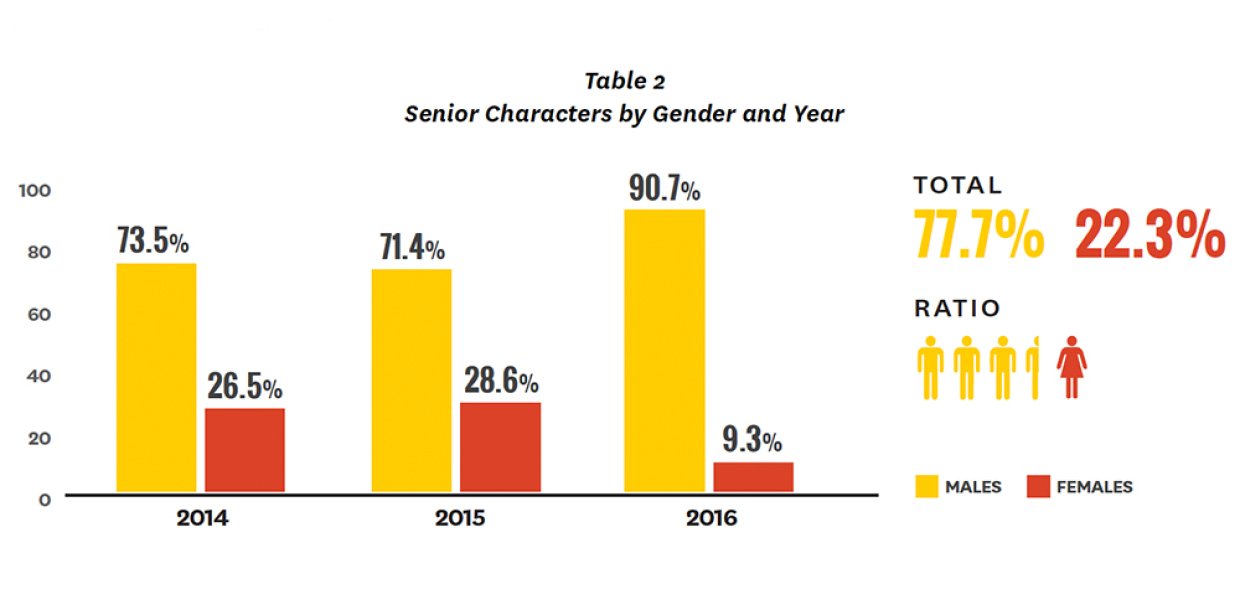Studies from Humana, USC Annenberg’s Professor Stacy L. Smith highlight ongoing prevalence of ageism in film, perceptions of real-life seniors
New research finds that characters aged 60 and over continue to be under and misrepresented in Hollywood’s most critically acclaimed films. Findings were uncovered through an ongoing partnership between health and well-being company Humana Inc. (NYSE: HUM) and the Media, Diversity, & Social Change Initiative at USC Annenberg. A separate but growing body of evidence exploring ageism suggests there are consequences to stereotypes of aging Americans—including potential negative health impacts.
Led by Professor Stacy L. Smith, USC’s study analyzed 1,256 speaking or named characters in the 25 Academy Award for Best Picture-nominated films in 2014, 2015, and 2016, to assess the portrayal of characters aged 60 and over. In tandem, Humana analyzed its own quantitative survey data on the attributes considered most important for aging Americans. One theme that emerged from the Humana data was the perceived importance of feeling optimistic, valued or recognized. If seniors aren’t accurately portrayed onscreen, might it impact their well-being in real life?
A deeper analysis of the findings shows:
Even in the most critically acclaimed films, aging characters are underrepresented and stereotypically portrayed.
- Of 1,256 characters evaluated, only 148 (11.8 percent) were 60 years of age or older – despite representing 18.5 percent of the U.S. population, according to the 2010 U.S. Census.[1]
- Six of the 14 films that featured a leading or supporting aging character contained ageist comments. Examples of these comments include “mentally feeble, sick old ladies” and “…just sit here and let Alzheimer’s run its course” – revealing that even critically acclaimed films misrepresent what it means to be a senior citizen.
There are inherent consequences to these stereotyped portrayals of aging Americans – including not feeling valued as a member of society and a potentially negative impact on health.
- Humana’s quantitative survey segmented seniors aged 60 and over by those who feel most valued, which was defined as being positively recognized and appreciated by family, friends and society.
- Those seniors who felt least valued reported more than twice as many physically unhealthy days and more than three times as many mentally unhealthy days per month as their “most valued” counterparts.
- Regardless of their health, most seniors agreed that film industry portrayals of their age group were inaccurate.
“The outcry over the lack of diversity at Hollywood’s premier award show has failed to recognize the value of senior voices on screen,” said Smith, director of the Media, Diversity & Social Change Initiative at USC Annenberg. “While 2016 best picture nominated films are more diverse when it comes to gender and some racial and ethnic groups, ageism is still an accepted form of exclusion in cinematic storytelling.”
Dr. Yolangel Hernandez Suarez, vice president and chief medical officer of care delivery at Humana, shared her own thoughts on the subject. “Clearly, there’s more work to be done before we can say precisely how inaccurate media portrayals impact self-image in seniors, from their sense of being valued to their sense of optimism, but what really concerns me as a physician is how a diminished sense of self-worth can, in turn, impact a senior’s health,” said Suarez. “In our survey, we showed that aging Americans who report feeling more valued in society tend to have more healthy days. At Humana, we believe aging with optimism contributes to health, and that’s why we’re committed to reversing societal perceptions and promoting aging with optimism.”
Key findings surrounding both studies will be showcased at “Over Sixty, Underestimated: A Look at Aging on the ‘Silver’ Screen in Best Picture-Nominated Films”, a discussion at the University of Southern California on Feb. 16. The event, which will be livestreamed at https://www.facebook.com/Humana/, will feature both Suarez and Smith joined by Dr. Caroline Cicero professor at USC Leonard Davis School of Gerontology, and Gary Lucchesi, president of the Producers Guild of America and president of Lakeshore Entertainment.
For the full report, please click ![]() here.
here.
About the Humana Quantitative Analysis
This survey includes 2,035 responses from U.S. adults aged 60 and older. Data weights are based on U.S. Census statistics for age, gender, geographic region, and race/ethnicity. It was conducted between Aug. 4- 21, 2016, and was designed to assess perceptions of the importance of various traits, characteristics or attributes of people as they age, then to have respondents rate themselves against the same attributes. Other data collected include general self-assessment of health, activity levels and perception of aging in popular culture. The survey also incorporated “Healthy Days,” a four-question survey developed and validated by the Centers for Disease Control and Prevention (CDC). It asks people how they perceive their recent health and how many days over the previous month they felt physically or mentally unwell.
About the USC Film Study
The Media, Diversity, & Social Change Initiative analyzed every speaking or named character in 25 films released in 2014, 2015, and 2016 and nominated for the Academy Award for Best Picture. Every speaking character was evaluated across a variety of measures (e.g., gender, race/ethnicity, LGBT status, and age). Characters that were 60 years of age or older on screen were identified (n=148) and a qualitative analysis related to health and occupation was performed for these characters. A further set of measures were used to qualitatively evaluate the portrayal of leading and supporting senior characters across the sample.
About Humana
Humana Inc., headquartered in Louisville, Kentucky, is a leading health and well-being company focused on making it easy for people to achieve their best health with clinical excellence through coordinated care. The company’s strategy integrates care delivery, the member experience, and clinical and consumer insights to encourage engagement, behavior change, proactive clinical outreach and wellness for the millions of people we serve across the country.
More information regarding Humana is available to investors via the Investor Relations page of the company’s web site at www.humana.com, including copies of:
- Annual reports to stockholders
- Securities and Exchange Commission filings
- Most recent investor conference presentations
- Quarterly earnings news releases
- Calendar of events
- Corporate Governance information
About USC Annenberg Media, Diversity, & Social Change Initiative
The Media Diversity & Social Change Initiative (MDSCI) at USC's Annenberg School for Communication and Journalism is a leading think tank studying diversity in entertainment through original and sponsored research. MDSCI findings create valuable and sought after research based solutions that advance equality in entertainment. Dr. Stacy L. Smith is the Founder and Director of the MDSCI. Dr. Smith and the MDSCI examine gender, race/ethnicity, LGBT, and disability on screen and gender and race/ethnicity behind the camera in cinematic content as well as barriers and opportunities facing women and people of color in the entertainment industry. The MDSCI also conducts economic analyses related to diversity and the financial performance of films. In 2015, Dr. Smith was named the #1 Most Influential Person in Los Angeles by LA Weekly. Dr. Smith has written more than 100 journal articles, book chapters, and reports on content patterns and effects of the media. In terms of the popular press, Dr. Smith’s research has been written about in The New York Times, Los Angeles Times, The Atlantic, Newsweek, The Hollywood Reporter, Variety, and NPR. She has a co-edited essay in Maria Shriver’s book, A Woman’s Nation Changes Everything (2009). Dr. Smith and the MDSCI’s most recent research reports include an analysis of 800 top-grossing films, the Comprehensive Annenberg Report on Diversity in Entertainment (CARD) and a series of landmark studies with Sundance Institute and Women in Film Los Angeles. To learn more, visit http://annenberg.usc.edu/mdsci or follow on Twitter @MDSCInitiative.
About the USC Annenberg School for Communication and Journalism
Located in Los Angeles at the University of Southern California, the Annenberg School for Communication and Journalism is a national leader in education and scholarship in the fields of communication, journalism, public diplomacy and public relations. With an enrollment of more than 2,200 students, USC Annenberg offers doctoral, graduate and undergraduate degree programs, as well as continuing development programs for working professionals, across a broad scope of academic inquiry. The school's comprehensive curriculum emphasizes the core skills of leadership, innovation, service and entrepreneurship and draws upon the resources of a networked university in a global urban environment. Based at the USC Annenberg School for Communication and Journalism in the heart of Los Angeles, the USC Center for Public Relations (CPR) is truly at the center of one of the world’s most dynamic professions. Our mission is to connect corporations, agencies, academics and students to define the future of our industry and to develop those who will shape it.
[1] U.S. Census Bureau (n.d.). Age Groups and Sex: 2010. Available: https://factfinder.census.gov/faces/tableservices/jsf/pages/productview.xhtml?pid=DEC_10_SF1_QTP1&prodType=table


